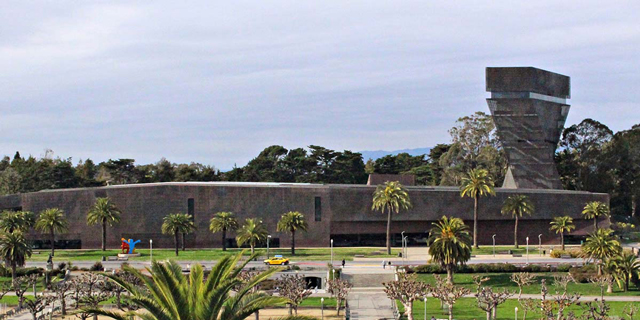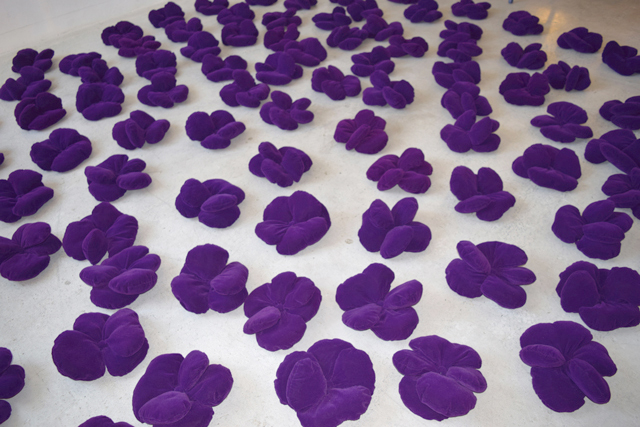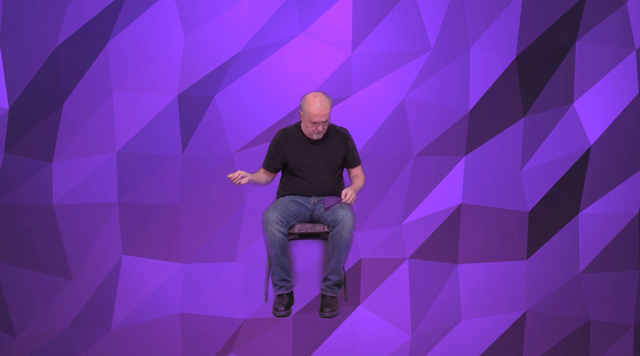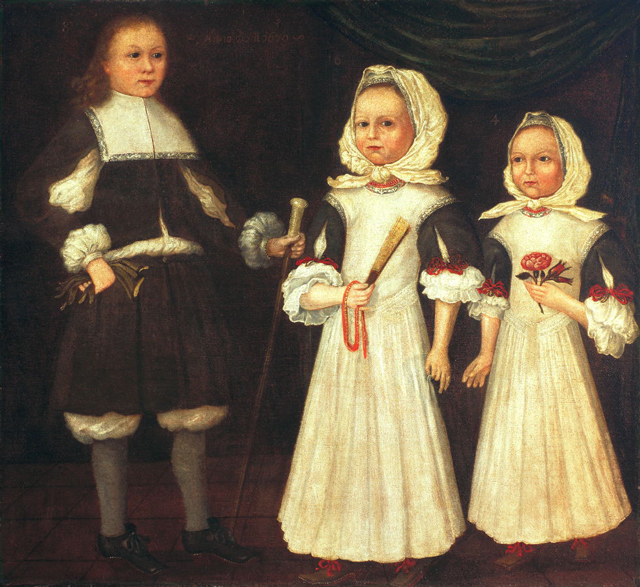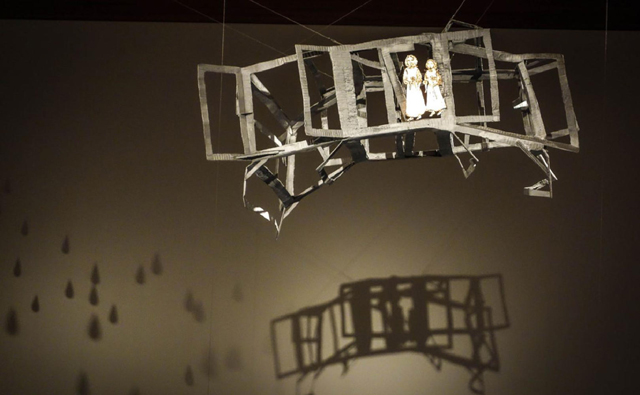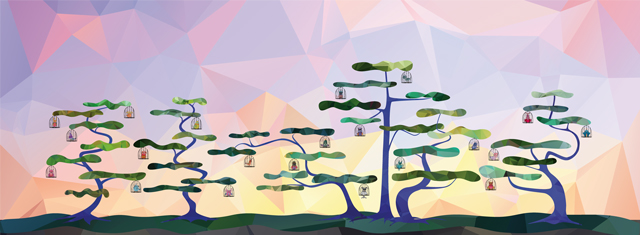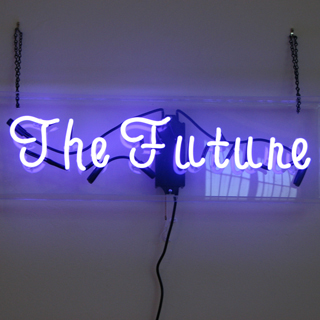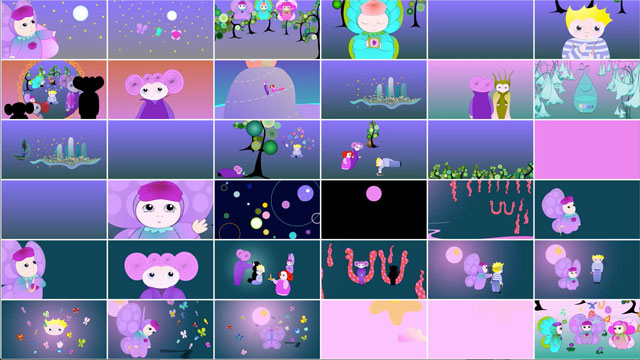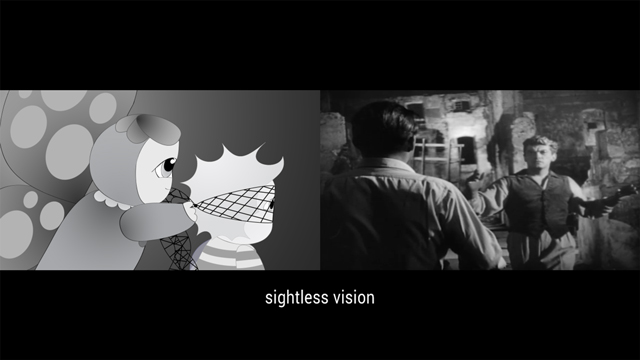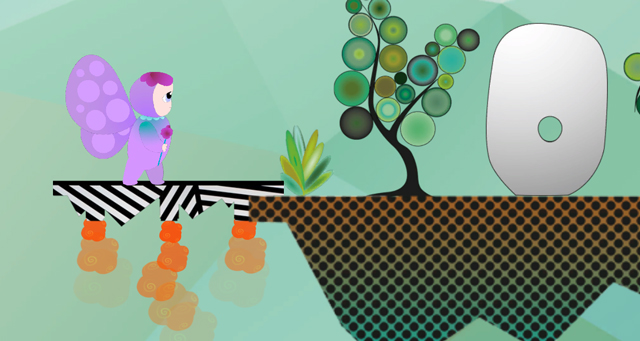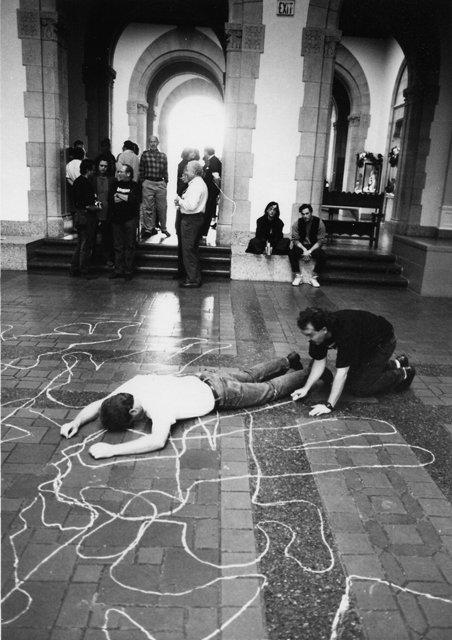The New World: Of Video Games and Museums
Rudy Lemcke, 2017
Shall I at Least Set My Lands in Order?
I sat upon the shore
Fishing, with the arid plain behind me
Shall I at least set my lands in order?
– T.S. Eliot, The Waste Land
The thesis that I am working through involves existential questions: How do we live and find meaning when our world is collapsing, when everything that once defined us is in the state of rapid transformation? How do we understand the institutions that house the symbolic and material richness of our past?
The Kimball Education Gallery – World Building
I’ve always considered the education departments of cultural institutions to be the most vital part of community building for the arts. It is the mesh between art, cultural production and the public. It is the space with which I most closely identify my social practice and the reason why I am so enthusiastic about being in the Kimball Education Gallery for the month of October. It’s a space where I can work through some of the concepts that I’ve been thinking about over the last few years in a dialogue with other artists and visitors to the de Young Museum.
The Project
I am envisioning the Kimball Gallery as a game space, as a play space where we can try out new ideas, new forms of making and new ways of seeing. Specifically, I am developing a video game in the space and using the gallery as a month long game development and research environment in order to rethink our connection to the museum and its permanent collection.
By initiating the play of ideas that happen in the studio this way, we open the possibility of rethinking the space itself, while redefining its inside and outside and perhaps reconsidering the central meaning of the institution that contains it.
The New World
The New World contains several elements that create multiple spatial and temporal modalities.
Pansy Field
Level Designs and Character Studies for Pansy Farm
Pansy Farm Game
Pansy Farm Work Station
Pansy Seed Boxes
Signage and Merchandise
Video Loops
Pansy Field
I spent several hours every night for 6 months sewing 100 purple velvet pansies for this project. The original concept for the pansy installation had no predefined final form. It started as an idea that there would be a field of purple velvet pansies in the gallery space. Instead of a fixed configuration, I will install it as an open field that will change positions every day according to my mood or a whim. During the 20 days of the residency I will create a drawing/score that represents each configuration.
Pansy Field is an unstable de-centering of the art object that becomes the frame within which my work in the gallery is developed. With no fixed form or center, it allows for multiple ways of seeing and interpreting the piece and sets the scene for the free play of new game ideas. Pansy Field and the video piece Self-Portrait Sewing Pansies is a celebration of growth, re-creation and re-invention and at the same time is an act of mourning and remembrance. (See footnotes 1 and 2)
Pansy Farm
Pansy Farm is a video game that is projected onto the wall of the Kimball Gallery. Visitors are invited to play the game. Preliminary sketches and notes for the game are pinned to the wall next to more formal drawings of characters and final renderings of the game levels.
Pansy Farm points to a destination that will never be realized within the game itself. There is no end to this game, no final scene, no final achievement. The game space calls out to the viewer to become a part of it. It is a meta-game, a game within a game.
Level One, the de Young World circles back upon itself in an endless loop of re-spawned characters. We participate in their eternal destruction and reappearance. We are never able to leave Level One nor are we able to move to Level Two, The World of Avatars, because this level is taking place outside of the digital video game space. The co-creation of Level Two takes place in the gallery at the Pansy Farm Work Station where visitors develop characters and rules for new game-play. Level Three, the Pansy World Level, is an abstraction, a stand in, a fantastic space that exists in the minds of artists as the possibility of future worlds.
Look and Feel
A “retro gamer” aesthetic is used in designing the game because much of the innovation in the “game world” community is coming from independent programmers and artists who are re-thinking, re-visiting, and re-exploring early video game spaces as an alternative to games that reflect the military industrial complex or war simulations. Indi Games (Independent Games) question the frame within which they are produced and distributed.
Game Characters and Objects
On display in the gallery are approximately 40 prints on vinyl. They are character and level studies that I have developed as stand alone art objects in order to give the gallery the feeling of walking into a game world. They use inexpensive industrial materials as an aesthetic choice that reflects the rapid prototyping of digital production.
There are four main groupings of prints: Fairies, Pansies, Birds and Worlds.
 |
 |
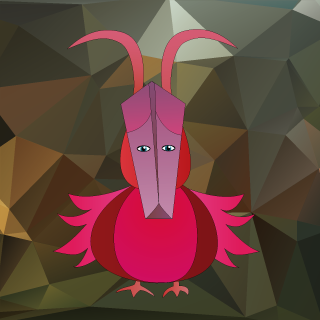 |
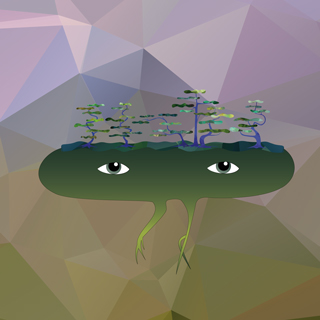 |
Figure and ground
For the backgrounds of the prints, I used a computational algorithm to extract the color palettes from major Modernist paintings to create a fragmented field. For example, the palette of Mont Sainte-Victoire Seen from Bellevue by Paul Cezanne, 1895, is used for the background for Bird with Mask A. (Figure 1) The palette of Les Demoiselles d’Avignon by Pablo Picasso, 1907 is used for World 7. (Figure 2) The palette of one of Monet’s Water Lilies paintings (circa 1915-1926) is used for the background of Game Worlds. (Figure 3)
Figures 1 & 2
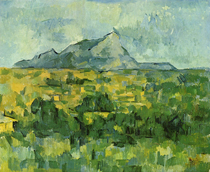 |
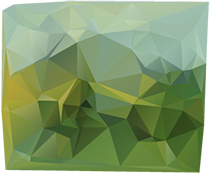 |
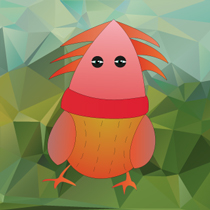 |
 |
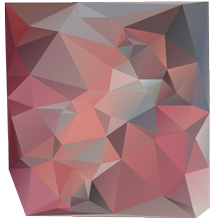 |
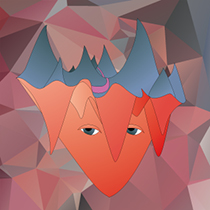 |
Figure 3
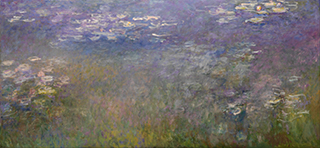 |
 |
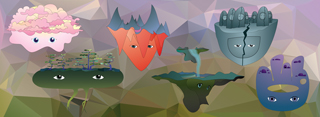 |
The Game, Players, Obstacles and Props
In the opening sequence of the game, a fairy character encounters twin girls who set the course for the game. “Our world is in ruins. Help us find the Pansy Farm,” they say.
The Fairy anti-hero, jumps and flies from shards of the copper skin of the collapsed structure, and dematerialize (blow up) avatars of iconic Modernist sculptures by artists such as Brancusi, Judd, Smith, Moore, Hepworth, Picasso and Duchamp in order to collect pansy magic (an as yet defined power) needed to create the “New World.”
The twin girls that appear in the opening sequence to Level One reference Kiki Smith’s installation, Near (2005) – part of the de Young’s permanent collection. In this piece Smith references the painting, David, Joanna, and Abigail Mason (1670), attributed to the Freake-Gibbs Painter, also a holding of the de Young in its American Paintings Collection.
 |
 |
 |
 |
Images, clockwise:
Black Figures, (1963), Lithograph, Henry Moore. The Achenbach Foundation Collection, FAMSF.
Moore Character, (2017) print on vinyl, 36 x 36″, Rudy Lemcke
Sphinx, (1912) Arthur Putnam
Sphinx, (2017) print on vinyl, 36 x 36″, Rudy Lemcke
Work Station – Level Two
The Work Station functions at the heart of the residency. It consists of a worktable, two laptops, two video projectors, drawing paper, misc. drawing tools and supplies. Interactive videos are projected from the Work Station onto the East and West walls of the gallery – inviting participation and activation of the gallery game space.
Laptop #1 – East Wall
Pansy Farm is projected from a laptop onto the East wall of the gallery. The player is able to use a “Play Station 4” controller device to move through and interact with the game.
Laptop #2 – West Wall
The second laptop projects the index of work in the permanent collection of the San Francisco Fine Arts Museums onto the opposite wall. Visitors can preview the hundreds of images in the museums’ database.
This is an open game opportunity for the visitors. Together we will sketch and design paper masks using artworks from the collection as references. These masks will be the jumping off point for the development of new characters/avatars and a new game level.
I have created preliminary images of bird creatures behind strange masks as the seed idea for a possible game path; but there are no-predefined rules or fixed characters for the game level.
In what new ways can the public interact with a database of objects that represent multiple histories of material culture? What alternative spaces/levels can we design to give these objects new meaning. This is the central question and game.
The Pansy Seed Farm Boxes
In a nod to Andy Warhol’s Brillo Box sculptures, the Pansy Seed Farm Boxes that are installed adjacent to the workstation represent the commodity container in which contemporary art is exchanged. The sculpture amplifies the idea of creative labor and the socio-economic system of production within which the art object acquires value. The sculpture uses the playful metaphor of art as a creative seed container. It stands along side and not in opposition to the game workstation.
Signage
This piece was originally made for an installation at SOMArts Gallery in San Francisco titled, City of the Future (after Tarkovsky’s Solaris), 2007.
A neon sign reads, “The Future.” It is a pastiche of Bruch Nauman and subsequent artists who have used commercial neon signage in their work. It points to an imaginary space and time that will never be realized.
Merchandise
In exchange for their collaborative work on this project, visitors will receive “Pansy” and “Fairy” buttons that have been manufactured for the installation.
Video Screens
There are four glass video projection screens in the Kimball Gallery that loop four recent video works: Fey Ontology, Self Portrait Sewing, Orpheus (The Poetics of Finitude), and Game Play.
Video 1: Fey Ontology
This video is a remix of the animation, Orpheus, a film that I created in 2015. In this variation, I display all 36 scenes in the animation simultaneously as an experiment in polytemporality (the simultaneous occurrence of multiple time streams – see footnote 3).
Video 2: Self Portrait Sewing Pansies
Sewing the velvet pansies for the Pansy Field sculpture.
Video 3: Orpheus (The Poetics of Finitude)
An experimental video based on my research and work on the Orpheus myth. It contains video fragments from Cocteau’s Orphée, 1950.
Video 4: Game Play
This is a short video recording of Pansy Farm game play.
Notes for Future Game Designers
Here are a few things to consider when embarking on designing a game.
These ideas come at you as fragments. Some are easily answered; some take time to flesh out.
Purpose
What is the point of the game – the objective of the game?
What is the reason for the game – “for the sake of which” it is being developed?
Space/Place
Where are we?
What type of space are we creating? For whom is it being created?
Does it mirror the lived world? Should it? Or is it a fantasy space? Whose fantasy?
Rules and Methods
Is there a goal, or is it free play?
What are the rules of the game?
Are there obstacles? Are these obstacles seen as enemies or puzzles to be solved?
Do game objects have intelligence?
Are there rewards? Punishments?
What is the temporal feel of the game?
What are the aesthetics of this space? What is the look and feel of the game?
What is the end-game strategy? How do we exit the game?
Characters/Players
Who is playing the game?
From what vantage point is the action experienced?
Is the player 3rd person or first person?
Is the player playing or watching the internal process of a fixed set of game rules?
Is the player playing or watching an internal process of an emergent experience?
How do we imagine and create a character?
Is the character first person, are they wearing a mask, using an avatar?
Is the character third person, viewed from a frame? What frame?
How do we animate a character? How does the character move?
What can the character do?
How do they interact with other characters, with other players, and with the environment?
Can the characters die?
Levels/Environments
Is this a multi-level game? How do the levels differ?
Can we move between levels?
How do the different levels affect the character’s abilities?
What are the rules of engagement for each level?
Does the game have intelligence?
An After Thought and Question for Future Game Designers
What is the meta-play of the game?
This understanding often comes after the game is in post-production or completed. It is the awareness of an unforeseen dimension of the game that emerges from the process of creation and draws us forward into the world.
FOOTNOTES
#1. Immemorial
This residency will mark my second time at the de Young. In 1992, I was invited by Harry Parker (a former director of the museum) to create an installation in the Hearst Court for December 1st, World AIDS Day. The piece was called, Immemorial. It was a performance where I enacted a die-in with de Young staff and visitors. During AIDS protests, people would perform die-ins by falling down on the ground as others drew their outlines in chalk. The trope was taken from police crime scenes and was meant to represent the place where a dead body was found. In the context of an AIDS demonstration, it was a political action that symbolized the lives lost in the epidemic. The reenactment of this gesture brought the political engagement of AIDS activism into the museum space.
The traces of bodies in chalk remained on the floor of the Hearst Court for the day.
#2. The Uninvited
The Uninvited, Single Channel Video, 13 min. 2003, was included in the Art AIDS America exhibition, co-curated by Jonathan David Katz and Rock Hushka.

The Uninvited, Single Channel Video, 13 min. 2003, was included in the Art AIDS America exhibition, co-curated by Jonathan David Katz and Rock Hushka.
strange theater
of shadows
lingers
a moment between
chaos and absolute silence
voices of the submerged
its sweet poisonous music
this haunting
and I
shadow master
its memory
these uninvited
– The Uninvited (excerpt), Rudy Lemcke
#3 The Polytemporal
In music “polytemporal” means that a composition has multiple time streams—polyrhythms, metric modulations, multiple tempi, and precisely calculated independent continuous tempo changes. The New World explores this notion. Among other ideas, the installation is meant to prompt many different understandings and experiences of temporality – that is, of the relations between now and then, fast and slow, old and new, before and after.
Artist Bio
I am a new media artist, curator and founding member of Queer Cultural Center and Creative Labor – artist run spaces. I am the co-organizer of Queer Conversations on Culture and the Arts collaboration between Queer Cultural Center and California College of the Arts Lecture Series and founder of Creative Labor’s Emerging Scholars Program, a program that brings young scholars together in community settings.
My artworks have been exhibited internationally. Recently, my work was included in the exhibition Art AIDS America curated by Jonathan D. Katz and Rock Hushka. My curatorial projects include: A History of Violence, (upcoming) 2018, From Self to #Selfie 2017, Creative Labor QIY (Queer-It-Yourself) 2016, and GlitterBomb 2015.
For more information please visit: www.rudylemcke.com
